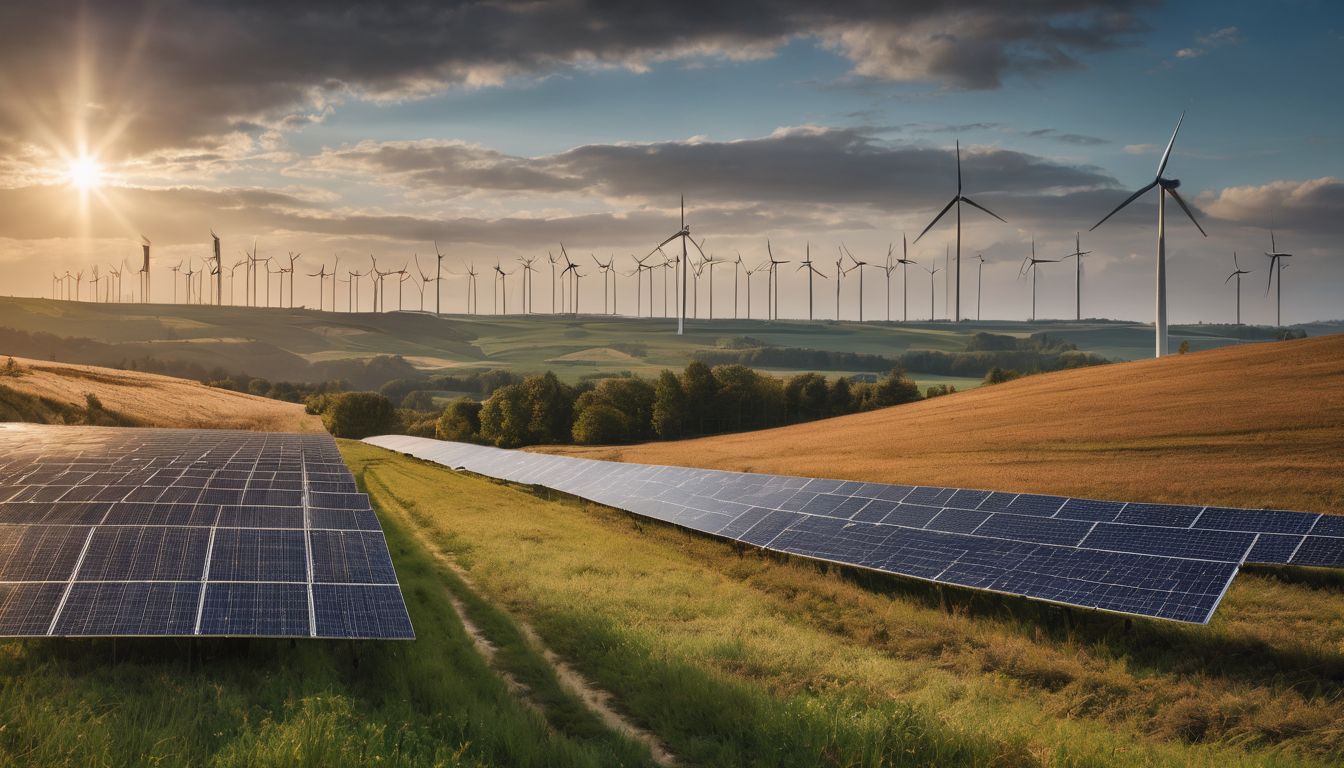Struggling to understand your energy bill? You’re not alone. Many of us find the array of tariffs confusing, especially when wanting to choose a greener option. This guide will clear up the fog around green energy tariffs and suppliers, helping you make an informed choice for the planet.
Let’s get started on this eco-friendly journey.
Key Takeaways
- Green energy tariffs are plans that match your electricity use with renewable sources such as wind or solar power, increasing demand for clean energy.
- By choosing a Utility Green Tariff, you reduce your carbon footprint and encourage investment in sustainable energy technologies.
- Comparing green tariffs from different suppliers helps find the most cost – effective and environmentally friendly option for you.
- In the UK, ethical green energy providers offer various schemes like REGO certifications and Feed-In Tariffs to support renewable energy usage.
- Implementing renewable energy solutions such as solar panels or wind turbines can lower business electricity costs and showcase environmental responsibility.
Understanding Utility Green Tariffs
Utility Green Tariffs offer consumers the option to support renewable energy and reduce their carbon footprint. Understanding how they work, their advantages and challenges, and the difference between them and Utility Green Power Products is crucial in making informed decisions about energy consumption.
What are Utility Green Tariffs?
Utility Green Tariffs are special energy plans that allow customers to support renewable energy production. When you choose a green tariff, the electricity you use is matched with renewable sources like wind or solar power.
Essentially, your electric utility company buys renewable energy on your behalf. This means that the more people sign up for these tariffs, the more demand there is for clean energy.
It’s an effective way to promote environmental sustainability while managing your energy consumption.
Choosing this type of tariff sends a strong message to the market—customers want cleaner energy options. Not only does it help reduce your own carbon footprint, but it also supports the growth of ecofriendly power industries.
By selecting a Utility Green Tariff you play an active role in encouraging companies and governments to invest more in sustainable energy technologies and infrastructure.
How do they work?
Green energy tariffs work by allowing consumers to support renewable energy generation through their electricity bills. Instead of relying solely on traditional fossil fuel-based power, green tariffs enable users to contribute to the production of clean energy.
When you opt for a green tariff, your supplier ensures that a percentage of the electricity you use comes from renewable sources such as wind, solar, or hydroelectric power. This helps to reduce overall reliance on non-renewable resources and supports the growth of sustainable energy infrastructure.
By choosing a green energy tariff, individuals can actively participate in reducing their carbon footprint and promoting environmental sustainability.
Advantages and challenges
Utility Green Tariffs offer several advantages and challenges, including:
- Potential cost savings on energy bills while supporting renewable energy sources.
- Demonstrating your commitment to environmental responsibility and sustainability.
- Encouraging the growth of renewable energy generation in the region, contributing to a greener future.
- Challenges may include navigating the complexity of green tariffs and understanding their impact on your specific energy usage.
- Balancing the initial investment with long – term benefits of supporting renewable energy.
Difference between a Utility Green Tariff and a Utility Green Power Product
Utility Green Tariffs and Utility Green Power Products both offer ways to support renewable energy, but they function differently. A Utility Green Tariff allows customers to pay a premium for electricity sourced from renewable resources, while still receiving their power through the local utility company’s grid.
On the other hand, a Utility Green Power Product enables customers to directly purchase renewable energy from a specific generator or supplier, with the option of selecting the source and amount of green power.
Ultimately, choosing between these options depends on whether you prefer supporting renewable energy indirectly through your utility company or directly through a particular green power provider.
Checking if your state has Utility Green Tariffs
To find out if your state has Utility Green Tariffs, you can follow these steps:
- Contact your local Public Utility Commission to enquire about green energy options available in your area.
- Visit the website of your electricity supply company to look for information on green power programmes and tariffs.
- Research renewable energy tariffs offered by different energy providers in your state to compare the options available.
- Explore eco – friendly energy schemes and programmes offered by public utility commissions to support conservation and environmental efforts.
Benefits of Switching to a Green Energy Supplier
Switching to a green energy supplier can significantly reduce your carbon footprint and support the use of renewable energy sources. It’s an environmentally friendly choice for those who are committed to making a positive impact on the planet.
Reduced carbon footprint
Switching to a green energy supplier can significantly reduce your carbon footprint. By choosing renewable energy sources such as wind, solar, or hydroelectric power, you can decrease the amount of greenhouse gases released into the atmosphere compared to traditional fossil fuel-based electricity generation.
This proactive choice contributes to mitigating climate change and supports a cleaner environment for future generations.
Embracing green energy options not only reduces your environmental impact but also sets an example for others in the community. Opting for renewable tariffs demonstrates a commitment to sustainable practices and encourages the wider adoption of eco-friendly energy solutions throughout society.
Supporting renewable energy
When businesses and individuals switch to a green energy supplier, they actively support renewable energy sources such as wind, solar, and hydroelectric power. This helps reduce the reliance on fossil fuels and lowers carbon emissions.
By choosing green energy tariffs or products, you contribute to the expansion of sustainable energy infrastructure and promote a greener future for generations to come.
Engaging with ethical electricity supply companies also encourages innovation in the renewable energy sector while driving down costs for eco-friendly options. Making this shift not only benefits the environment but also demonstrates a commitment to sustainability, setting an example for others and contributing to global efforts in combating climate change.
Choosing a Green Energy Supplier
When choosing a green energy supplier, it’s important to look for providers that offer renewable energy sources and have a strong commitment to sustainability. Comparing energy suppliers and tariffs can help you find the best option for your eco-friendly energy needs.
What to look for in an energy provider
When choosing an energy provider, consider the following:
- Environmental commitment: Look for suppliers with a strong focus on renewable energy sources and sustainable practices.
- Green tariff options: Check if the supplier offers specific green tariffs that support renewable energy generation.
- Tariff comparison tools: Ensure the supplier provides tools to compare green tariffs with standard options, allowing you to make an informed decision.
- Customer support: Seek suppliers who offer excellent customer service and are transparent about their environmental policies.
- Energy efficiency advice: Choose a supplier that provides advice on how to improve your energy efficiency and reduce your carbon footprint.
- Ethical business practices: Look for providers committed to ethical sourcing and investing in eco-friendly initiatives.
Comparing energy suppliers and tariffs
Comparing energy suppliers and tariffs is crucial for making an informed decision. Below is an HTML table to aid in assessing various energy suppliers and their tariffs:
| Supplier | Tariff Name | Annual Cost Estimate | Green Energy % | Exit Fees | Customer Rating |
|---|---|---|---|---|---|
| Green Energy UK | Sparkling Tariff | £1,200 | 100% | £0 | 4.5/5 |
| Ecotricity | Green Electricity | £1,300 | 100% | £0 | 4.3/5 |
| Good Energy | Good Tariff | £1,250 | 100% | £30 | 4.2/5 |
| Bulb | Vari-Fair | £1,100 | 100% | £0 | 4.4/5 |
| Octopus Energy | Super Green Octopus | £1,150 | 100% | £0 | 4.5/5 |
Select a supplier with a high percentage of green energy and favorable customer ratings. Consider the annual cost estimates and potential exit fees. Choose a tariff that aligns with your environmental values and budget.
Generating renewable energy for your business
When considering the generation of renewable energy for your business, it is important to explore environmentally friendly options. Investing in solar panels, wind turbines, or hydropower systems can significantly reduce your carbon footprint and contribute positively towards environmental conservation.
By harnessing renewable energy sources, businesses can showcase their commitment to sustainability while also benefiting from potential cost savings on electricity bills.
Exploring green power options for your business involves evaluating the feasibility and benefits of installing renewable energy systems such as solar panels or wind turbines. It’s essential to consider factors like available space, local regulations, upfront costs, and long-term savings when making this decision.
Ethical and Green Energy Suppliers in the UK
Explore the various types of green schemes and tariffs available with ethical energy suppliers in the UK. Learn about how you can make a positive impact on the environment by choosing a green energy provider.
Background information
Green energy suppliers in the UK offer a variety of green schemes and tariffs to help individuals and businesses reduce their carbon footprint. By choosing a green energy supplier, you can support renewable energy sources such as wind, solar, or hydroelectric power.
These ethical and environmentally friendly options not only contribute to conservation efforts but also align with your values as an eco-conscious consumer. Understanding the different types of green power products available will enable you to make informed decisions about switching to a sustainable energy provider.
Now let’s explore the various types of green power supply options that are offered by ethical and industry-leading companies in the UK market.
Types of green schemes and tariffs available
When looking for green energy schemes and tariffs, consider the following options:
- Renewable Energy Guarantees of Origin (REGO) certification to verify renewable sources.
- Time of use tariffs that encourage energy consumption during off-peak hours.
- Feed – In Tariffs (FITs) for generating renewable energy and selling excess back to the grid.
- Green Gas Certificates for offsetting carbon emissions from gas usage.
- Offsetting programs where suppliers invest in environmental projects to balance out your carbon footprint.
Green Power Supply Options
Explore the different types of green power products available, including solar, wind, and hydro energy. Understand how each option can benefit your business and contribute to a more sustainable future.
Different types of green power products
Green power products come in various forms, offering environmentally conscious individuals the opportunity to support conservation and environmental causes. Here are some options available for those looking to make a positive impact:
- Renewable Electricity: This includes electricity generated from renewable sources such as wind, solar, hydro, and biomass.
- Renewable Energy Certificates (RECs): These represent the environmental attributes of energy generated from renewable sources and can be purchased separately from the electricity itself.
- Green Gas: This refers to biogas or biomethane produced from organic waste materials or by capturing methane emissions from agricultural and landfill sites.
Conclusion
In conclusion, understanding utility green tariffs and switching to a green energy supplier can significantly reduce your carbon footprint. Choosing an ethical and eco-friendly energy provider is vital for supporting renewable energy.
Exploring the available green power supply options allows you to make informed decisions about generating renewable energy for your business.
FAQs
1. What are energy tariffs and why do they matter?
Energy tariffs are the prices that you pay for your gas and electricity. They matter because finding the right tariff can save you money and help address environmental issues by choosing ecofriendly energy sources.
2. How do green energy suppliers support ethical and environmental issues?
Green energy suppliers focus on providing electricity from renewable sources like wind or solar power, which helps reduce carbon emissions and supports ethical environmental practices.
3. Can switching to a green energy supplier lower my electricity prices?
Switching to a green energy supplier might not always lower your electricity prices immediately, but it often leads to savings over time due to government incentives supporting ecofriendly energy usage.
4. Is it complicated to change to an ecofriendly energy tariff?
No, changing to an eco-friendly energy tariff is straightforward; many suppliers offer clear guidance through the process making it easy for you to switch and support renewable resources.





